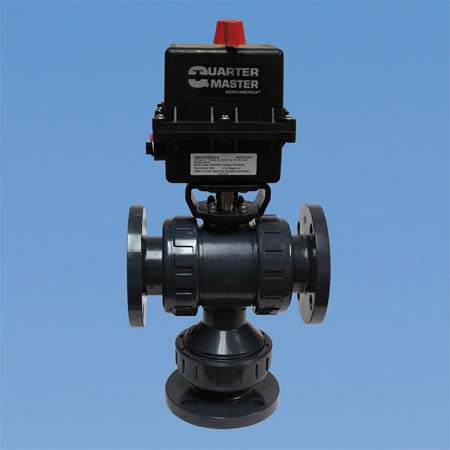Actuated Plastic Ball Valves
Electronically Actuated Series 94 on Type-23 Multiport® Valve (1/2" – 3")
An electric actuator is, essentially, a geared motor. The motor can be of various voltages, and is the primary torque-generating component. To prevent heat damage from overwork or excessive current draw, electric actuator motors are usually equipped with a thermal overload sensor embedded in the motor windings. This sensor is wired in series with the power source and opens the circuit if the motor overheats. The circuit closes again when the motor reaches a safe operating temperature.
An electric motor consists of an armature, an electrical winding, and a gear train. When power is supplied to the winding, a magnetic field is generated causing the armature to rotate. The armature will rotate as long as there is power to the windings. When the power is cut, the motor stops. Standard end-of-travel limit switches, which are a necessity for an electric actuator, handle this task.
Electric actuators rely on a gear train, which is coupled directly from the motor to enhance the motor torque and dictate the output speed of the actuator. The only way to change the output speed is to install a cycle length control module. This module allows an increase in cycle time only. If a decrease in cycle time is required, an alternate actuator with the desired cycle time and proper output torque must be used.
There are two types of motors used for electric actuators: uni-directional and bi-directional (commonly known as reversing motors).
- Uni-directional motors are motors in which the armature rotates in one direction, causing the valve to rotate in one direction. These actuators are typically used with a ball valve and rotate in 90 or 180 degree increments; strictly for an on/off type of service.
- Reversing motors are motors in which there are two sets of windings allowing the armature to rotate in either direction, depending on which set of windings is powered. One set of windings controls the clockwise direction for closing a valve, while the other set of windings controls the counter-clockwise direction for opening the valve. A major benefit of a bi-directional actuator is precise flow control, as the actuator is not required to travel the full stroke to begin the reverse stroke.
Resources
Data Sheet

